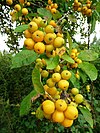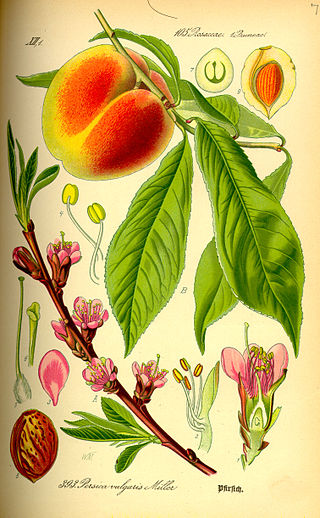
The peach is a deciduous tree first domesticated and cultivated in Zhejiang province of Eastern China. It bears edible juicy fruits with various characteristics, most called peaches and others, nectarines.

A plum is a fruit of some species in Prunus subg. Prunus. Dried plums are most often called prunes, though in the United States they may be just labeled as 'dried plums', especially during the 21st century.

Domestication is a multi-generational mutualistic relationship between humans and other organisms, in which humans took over control and care to obtain a steady supply of resources including food. The process was gradual and geographically diffuse, based on trial and error.

The cucumber is a widely-cultivated creeping vine plant in the family Cucurbitaceae that bears cylindrical to spherical fruits, which are used as culinary vegetables. Considered an annual plant, there are three main types of cucumber—slicing, pickling, and seedless—within which several cultivars have been created. The cucumber originates in Asia extending from India, Nepal, Bangladesh, China, and Northern Thailand, but now grows on most continents, and many different types of cucumber are grown commercially and traded on the global market. In North America, the term wild cucumber refers to plants in the genera Echinocystis and Marah, though the two are not closely related.

Morus, a genus of flowering plants in the family Moraceae, consists of diverse species of deciduous trees commonly known as mulberries, growing wild and under cultivation in many temperate world regions. Generally, the genus has 64 subordinate taxa, three of which are well-known and are ostensibly named for the fruit color of the best-known cultivar: white, red, and black mulberry, with numerous cultivars and some taxa currently unchecked and awaiting taxonomic scrutiny. M. alba is native to South Asia, but is widely distributed across Europe, Southern Africa, South America, and North America. M. alba is also the species most preferred by the silkworm, and is regarded as an invasive species in Brazil and the United States.

Malus is a genus of about 30–55 species of small deciduous trees or shrubs in the family Rosaceae, including the domesticated orchard apple, crab apples and wild apples.
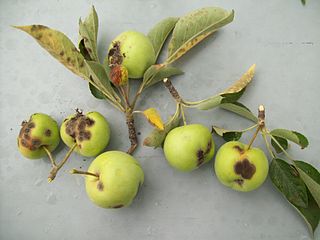
Apple scab is a common disease of plants in the rose family (Rosaceae) that is caused by the ascomycete fungus Venturia inaequalis. While this disease affects several plant genera, including Sorbus, Cotoneaster, and Pyrus, it is most commonly associated with the infection of Malus trees, including species of flowering crabapple, as well as cultivated apple. The first symptoms of this disease are found in the foliage, blossoms, and developing fruits of affected trees, which develop dark, irregularly-shaped lesions upon infection. Although apple scab rarely kills its host, infection typically leads to fruit deformation and premature leaf and fruit drop, which enhance the susceptibility of the host plant to abiotic stress and secondary infection. The reduction of fruit quality and yield may result in crop losses of up to 70%, posing a significant threat to the profitability of apple producers. To reduce scab-related yield losses, growers often combine preventive practices, including sanitation and resistance breeding, with reactive measures, such as targeted fungicide or biocontrol treatments, to prevent the incidence and spread of apple scab in their crops.
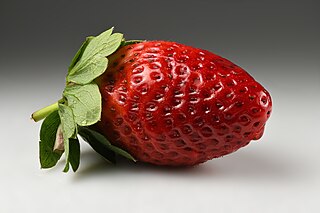
The garden strawberry is a widely grown hybrid species of the genus Fragaria, collectively known as the strawberries, which are cultivated worldwide for their fruit. The fruit is widely appreciated for its characteristic aroma, bright red color, juicy texture, and sweetness. It is consumed in large quantities, either fresh or in such prepared foods as jam, juice, pies, ice cream, milkshakes, and chocolates. Artificial strawberry flavorings and aromas are also widely used in products such as candy, soap, lip gloss, perfume, and many others.

Malus sylvestris, the European crab apple, also known as the European wild apple or simply the crab apple, is a species of the genus Malus, native to Europe and western Asia. Its scientific name means "forest apple".

Anthocyanins, also called anthocyans, are water-soluble vacuolar pigments that, depending on their pH, may appear red, purple, blue, or black. In 1835, the German pharmacist Ludwig Clamor Marquart gave the name Anthokyan to a chemical compound that gives flowers a blue color for the first time in his treatise "Die Farben der Blüthen". Food plants rich in anthocyanins include the blueberry, raspberry, black rice, and black soybean, among many others that are red, blue, purple, or black. Some of the colors of autumn leaves are derived from anthocyanins.

An apple is a round, edible fruit produced by an apple tree. Apple trees are cultivated worldwide and are the most widely grown species in the genus Malus. The tree originated in Central Asia, where its wild ancestor, Malus sieversii, is still found. Apples have been grown for thousands of years in Asia and Europe and were introduced to North America by European colonists. Apples have religious and mythological significance in many cultures, including Norse, Greek, and European Christian tradition.

A crop wild relative (CWR) is a wild plant closely related to a domesticated plant. It may be a wild ancestor of the domesticated (cultivated) plant or another closely related taxon.

The fig is the edible fruit of Ficus carica, a species of small tree in the flowering plant family Moraceae, native to the Mediterranean region, together with western and southern Asia. It has been cultivated since ancient times and is now widely grown throughout the world. Ficus carica is the type species of the genus Ficus, containing over 800 tropical and subtropical plant species.

Malus niedzwetzkyana, or Niedzwetzky's apple, is a kind of apple native to certain parts of China, Afghanistan, Kazakhstan, Kyrgyzstan, and Uzbekistan noted for its red-fleshed, red-skinned fruit and red flowers. Some botanists consider it a distinct species, while others have argued it is simply an unusual variety of the common apple, Malus pumila.
Applecrabs are various hybrids between crabapples and apples. They are bred for varying reasons, including disease resistance and use in cold climates because they are often hardier than apple trees and their fruit has the good eating qualities of apples.

Flamenco, also known as Ballerina Obelisk, is a cultivar of domesticated apple that bears apples good for eating fresh, and is grown for its unusual ornamental properties. The tree grows in a straight up columnar style, with many small fruit-bearing branches. 'Flamenco' is one of a series of apple tree cultivars that share a registered trademark under the name Ballerina.
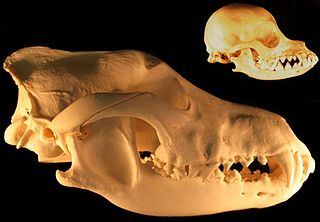
Domestication syndrome refers to two sets of phenotypic traits that are common to either domesticated animals, or domesticated plants. These traits were identified by Charles Darwin in The Variation of Animals and Plants Under Domestication.
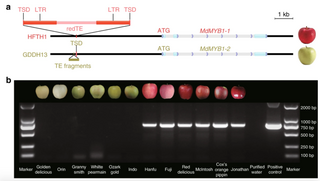
In 2010, an Italian-led consortium announced they had sequenced the first complete genome of an apple in collaboration with horticultural genomicists at Washington State University, using 'Golden Delicious'. The apple genome has approximately 57,000 genes, which was the highest number of any plant genome studied at the time, and more genes than the human genome which has about 25,000 genes. The modern apple has 17 chromosomes which were found to be derived from an ancestor with 9 chromosomes that experienced genome-wide duplication. The genome sequence also provided proof that Malus sieversii was the wild ancestor of the domestic apple—an issue that had been long-debated in the scientific community. In 2016 a new and much higher quality whole genome sequence (WGS) for a double-haploid derivative of the Golden Delicious variety of apple was published. This new understanding of the apple genome will help scientists identify genes and gene variants that contribute to resistance to disease and drought and other desirable characteristics. Understanding the genes behind these characteristics will help scientists perform more knowledgeable selective breeding.

Malus orientalis, the eastern crabapple or Caucasus apple, is a species in the genus Malus found in Bulgaria, Turkey, the Transcaucasus, and Iran. With its relatively large yellow fruit, it has been consumed by people for millennia, with a string of halved, dried fruit being found in a royal tomb at Ur. Drying the fruit and then rehydrating by boiling cuts the tartness. M. orientalis contributed slightly to the gene pool of domesticated apples, a distant second to Malus sieversii.

Awais Khan is a Pakistani-American plant geneticist and an associate professor at the College of Agriculture and Life Sciences, Cornell University.
























